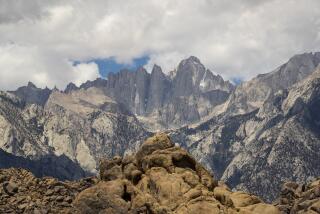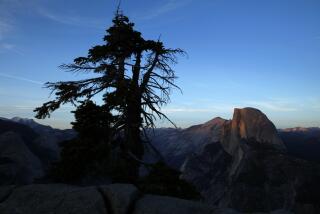Climbing Veterans Call Everest Deaths Inevitable
KATMANDU, Nepal — Mountaineers call it the “death zone,” a high-altitude, oxygen-starved environment where the weather is lethally fickle and the dry air and bitter cold quickly leech life from the human body.
As no fewer than 25 expeditions clawed their way up the icy flanks of Mt. Everest, the treacherous ways of the high Himalayas claimed eight climbers in recent days, including two Americans, after a freak blizzard pummeled the 29,028-foot mountain on the Nepal-Tibet border with shrieking winds and blinding snows.
One of the dead was a guide who sacrificed his life in a vain attempt to save an American customer--a heroic effort that contrasted with unconfirmed reports that a team on the other side of Everest ignored the plight of three struggling Indians and continued instead toward the summit.
The loss of life was one of the greatest on Everest since it was first scaled in May 1953--a toll some mountaineers said was the predictable, if sorrowful, outcome of pushing the human body to its limits in an extraordinarily hostile environment. More than 100 people have died on its slopes.
Other Everest veterans said the marketing of the world’s highest mountain and the growing popularity of companies assembling expeditions of paying customers are the reasons that so many people were on the peak at one time and that the loss of life was so great.
“The sad thing is . . . a lot of commercialization has come into it,” Capt. M. S. Kohli, advisor to the Indo-Tibetan Border Police and leader of a team to Everest in 1965, said in New Delhi.
When the blizzard struck Friday, there were no fewer than 11 expeditions on the southern, or Nepali, side and 14 on the northern, or Tibetan, slope, officials and outfitters said.
A television team from Britain was following actor Brian Blessed to the summit. An American expedition was trying to shoot the first IMAX wide-angle film of an Everest ascent.
A Rhode Island 16-year-old, Mark Pfetzer, was trying to become the youngest climber to scale the peak that Tibetans know as Chomolungma--”Goddess Mother of the Land.” On Sunday, his father said the high school sophomore and his group had been driven down from 26,000 feet to 18,000 feet by the snowstorm but that they planned to press on.
Seven years ago, Edmund Hillary of New Zealand, who first conquered Everest with his Nepalese partner, Tenzing Norgay, sounded a warning and a lament about what was happening to his beloved mountain.
“Mt. Everest has become a junk heap overloaded with multitudes of expeditions and their refuse,” said Hillary, who was then New Zealand’s high commissioner to India and Nepal. “Some of us believe that it should be closed down for five years and left alone to regenerate.”
These days, mountaineers say, there are sometimes so many groups waiting in base camps for a break in the weather that when it comes, a traffic jam can result on the climb to the summit and back.
Friday’s storm shattered a two-week window, known as the pre-monsoon lull, when climbing conditions are supposed to be at their best.
On the north face, the struggling Indian group--members of a climbing team from the Indo-Tibetan Border Police--reported winds of 75 mph. The three Indians are presumed dead.
On the south side of Everest, three expeditions were simultaneously trying to reach the summit. The blizzard caught them at their most vulnerable--stripped of most equipment to make the final push, and in the debilitating “death zone” above 26,400 feet.
“When you’re summiteering between base camp and the summit, you’re committed,” Kohli said. On Tuesday, communication with the base camps was still slow and information reaching Katmandu sketchy, but Dawa Norbu Sherpa, president of the Nepal Mountaineering Assn., said the climbers may not have given themselves enough time to return to base camp. They appeared to have set off for the summit late and reached it in midafternoon, Sherpa said.
*
Among the victims were some remarkably savvy and fit mountain climbers, including Rob Hall, 36, of New Zealand, an Everest veteran said by many mountaineers to be the most experienced non-Nepalese on Everest.
After reaching the peak for the fifth time, Hall trailed others in the expedition he was chaperoning in a futile attempt to help an American client as they descended Friday.
The New Zealander was traveling light because he had just made a drive to Everest’s summit, which entails a hard slog up a 40-degree incline and a rope climb up a 30-foot-high sheer rock wall known as the “Hillary Step.”
“Even 1 pound makes all the difference, so no one carries a sleeping bag,” Kohli said. “The most they may have is a down jacket. When you leave the base camp and push on to the summit, you are at the mercy of the weather.”
Climbers going for the pinnacle “carry a small oxygen cylinder and have no support teams anymore,” Sherpa said. And a standard bottle of pressurized oxygen, which weighs about 4 pounds, lasts four hours.
“Nobody who climbs questions dying on the mountains, and sooner or later it had to happen on Everest by the law of averages,” said Steve Bell, managing director of Himalayan Kingdoms Expeditions of Sheffield, England, and an Everest veteran. “What killed them was the storm. It doesn’t matter how good you are if you are caught out in it, whether you’re a seasoned climber with decades of experience or a relative newcomer.”
*
On Tuesday, Nepal’s Ministry of Tourism and Civil Aviation was still listing the vanished climbers as “missing.” No rescue attempts were made during the day.
One American, Seaborne Beck Weathers of Dallas, was rescued Monday along with a Taiwanese climber at 19,100 feet.
Meanwhile on Tuesday, an astonishing story was emerging on the Tibetan side of Everest. By satellite telephone, surviving members of the Indo-Tibetan Border Police told their New Delhi headquarters that a Japanese expedition had reneged on a promise to abandon its drive for the summit and help Indian climbers who spent a night on the mountain after reaching the peak at 6 p.m. local time Friday.
Instead, Kohli said, the Japanese appear to have made the ascent on Saturday. On the way, they said by walkie-talkie that they had spotted two bodies and stopped to help the third Indian, who was tangled in his rope, giving him some juice to rehydrate him. But on the way down, one of the Indians they had taken for dead was gone and the climber they untangled was nowhere to be found.
“Had the Japanese had the courtesy of detailing at least one Sherpa to help these men, they would have lived,” Kohli said. The Japanese Embassy in New Delhi said it had no information on what happened.
Participants in the increasing number of commercial Everest climbs now pay $65,000 and more to “have a shot at the Big One,” in Bell’s words, and some mountaineers believe that may give rise to safety risks.
“With such an investment, a person will be reluctant to abandon his attempt,” Kohli said.
Nepal takes no responsibility for climbers’ safety. Tourism is its chief source of foreign currency.
Times staff writer Dahlburg reported from New Delhi and special correspondent Adhikary from Katmandu.
More to Read
Sign up for Essential California
The most important California stories and recommendations in your inbox every morning.
You may occasionally receive promotional content from the Los Angeles Times.










